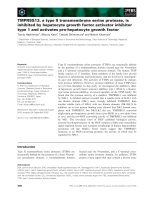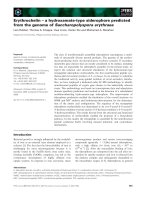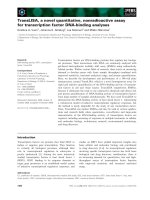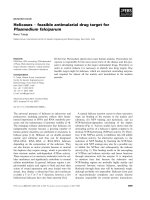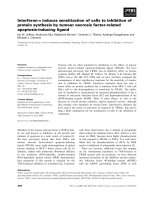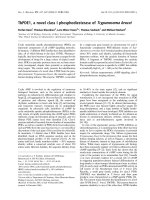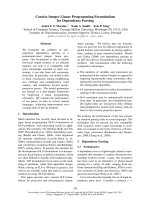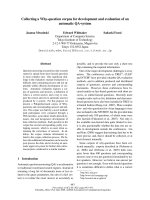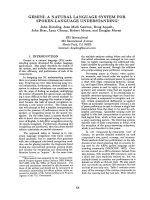Báo cáo khoa học: "Toward a Plan-Based Understanding Model for Mixed-Initiative Dialogues" pptx
Bạn đang xem bản rút gọn của tài liệu. Xem và tải ngay bản đầy đủ của tài liệu tại đây (695.14 KB, 8 trang )
Toward a Plan-Based Understanding Model for Mixed-Initiative Dialogues
This paper presents an enhanced model of
plan-based dialogue understanding. Most
plan-based dialogue understanding models
derived from [Litman and Allen, 1987] as-
sume that the dialogue speakers have access
to the same domain plan library, and that the
active domain plans are shared by the two
speakers. We call these features shared do-
main plan constraints. These assumptions,
however, are too strict to account for mixed-
initiative dialogues where each speaker has a
different set of domain plans that are housed
in his or her own plan library, and where
an individual speaker's domain plans may
be activated at any point in the dialogue.
We propose an extension to the Litman and
Allen model by relaxing the shared domain
plan constraints. Our extension improves (1)
the ability to track the currently active plan,
(2) the ability to explain the planning be-
hind speaker utterances, and (3) the ability
to track which speaker controls the conver-
sational initiative in the dialogue.
1. Introduction
In this paper, we present an enhanced plan-based model
of dialogue understanding that provides a framework
for computer processing of mixed-initiative dialogues.
In mixed-initiative dialogues, each speaker brings to
the conversation his or her own plans and goals based
on his or her own domain knowledge, and which do
not necessarily match those of the other speaker, even
in cooperative situations. Thus, mixed-initiative dia-
logues exhibit a more complicated discourse structure
than do dialogues in which a single speaker controls
the conversational initiative.
Hiroaki Kitano* and Carol Van Ess-Dykema t
Center for Machine Translation
Carnegie Mellon University
Pittsburgh, PA 15213
ABSTRACT The existing plan-based model of dialogue under-
standing (as represented by [Litman and Allen, 1987])
accounts for dialogues in which a single speaker con-
trois the initiative. We call these dialogues
Single-
Initiative Dialogues.
In modeling
single-initiative di-
alogues,
Litman and Allen assume a shared stack that
represents
ajointplan
(joint domain plan). This
joint
plan
is shared by the two speakers. We claim that
this assumption is too restrictive to apply to mixed-
initiative dialogues, because in mixed-initiative dia-
logues each speaker may have his or her own indi-
vidual domain plans I. The assumption creates several
functional problems in the Litman and Allen model,
namely, its inability to process mixed-initiative dia-
logues and the need for a large amount of schema def-
inition (domain knowledge representation) to handle
complex conversational interactions.
The model we present builds on the framework of
[Litman and Allen, 1987]. We hypothesize, how-
ever, that
speaker-specific plan libraries are needed,
instead of a single plan library
storing joint plans,
for
a plan-based theory of discourse to account for mixed-
initiativedialogues. In our framework, the understand-
ing system activates the instantiated schemata (places
them on the stack) from each speaker's individual plan
library 2, thus creating two domain plan stacks. We
also theorize that in addition to using the domain plans
that are stored in a speaker's memory (plan library),
speakers incrementally expand their domain plans in
response to the current context of the dialogue. These
extensions enable our model to."
*This author is supported, in part, by NEC Corporation,
Japan.
tThis author's research was made possible by a post-
doctoral fellowship awarded her by the U.S. Department of
Defense. The views and conclusions contained in this doc-
ument are those of the authors and should not be interpreted
as necessarily representing the official policies, either ex-
pressed or implied, of the U.S. Department of Defense or of
the United States government.
• Provide a mechanism for tracking the currently
active plan in mixed-initiative dialogues,
• Explain the planning behind speaker utterances,
• Provide a mechanism for tracking which speaker
controls the conversational initiative, and for
tracking the nesting of initiatives within a dia-
logue segment.
• Reduce the amount of schema definition required
to
process mixed-initiative dialogues.
Throughout this paper, we use two dialogue extrac-
lIn this regard, we agree with [Grosz and Sidner, 1990]'s
criticism of the
master-slave
model of plan recognition.
2Using the [Pollack, 1990] distinction, plans are
mental
objects
when they are on the stack, and
recipes-for-action
when they are in the plan library.
25
tions from our data: 1) an extraction from a Japanese
dialogue in the conference registration domain, and
2) an extraction from a Spanish dialogue in the travel
agency domain. 3 SpA and SpB refer to Speaker A and
Speaker B, respectively.
Dialogue I (Conference Registration, translated
from Japanese):
SpA:
SpA:
SpB:
SpB:
SpA:
SpB:
I would like to attend the conference. (1)
What am I supposed to do? (2)
First, you must register for the conference. (3)
Do you have a registration form? (4)
No, not yet. (5)
Then we will send you one. (6)
Dialogue II (Travel Agency, translated from Span-
ish):
Prior to the following dialogue exchanges, the traveler
(SpB) asks the travel agent (SPA) for a recommenda-
tion on how it is best to travel to Barcelona. They agree
that travel by bus is best.
SpA:
SpA:
SpB:
SpA:
SpA:
SpB:
You would leave at night. (1)
You would take a nap in the bus on your
way to Barcelona. (2)
Couldn't we leave in the morning
instead of at night? (3)
Well, it would be a little difficult. (4)
You would be traveling during the day
which would be difficult because it's
very hot. (5)
Really? (6)
2. Limitations of the Current Plan-Based
Dialogue Understanding Model
The current plan-based model of dialogue understand-
ing [Litman and Allen, 1987] assumes a single plan
library that contains the domain plans of the two speak-
ers, and a shared plan stack mechanism to track the
current plan structure of the dialogue. The shared
stack contains the domain plans and the discourse plans
from the plan library that are activated by the inference
module of the dialogue understanding system. The do-
main plan is a joint plan shared by the two dialogue
speakers. Although this shared stack mechanism ac-
counts for highly task-oriented and cooperative dia-
logues where one can assume that both speakers share
3Dialogue 1 is extracted from a corpus of Japanese ATR
(Advanced Telecommunication Research) recorded simu-
lated conference registration telephone conversations. No
visual information was exchanged between the telephone
speakers. Dialogue 2 is extracted from a corpus of recorded
Spanish dialogues in the travel agency domain, collected by
the second author of this paper. These dialogues are simu-
lated telephone conversations, where no visual information
was exchanged.
the same domain plan, the model does not account for
mixed-initiative dialogues.
In this section we examine three limitations of the
current plan-based dialogue understanding model: 1)
the inability to track the currently active plan, 2) the
inability to explain a speaker's planning behind his or
her utterances, and 3) the inability to track conversa-
tional initiative control transfer. A dialogue under-
standing system must be able to infer the dialogue par-
ticipants' goals in order to arrive at an understanding
of the speakers' actions. The inability to explain the
planning behind speaker utterances is a serious flaw in
the design of a
plan-based
dialogue processing model.
Tracking the conversational control initiative provides
the system with a mechanism to identify which of a
speaker's plans is currently activated, and which goal
is presently being persued. We believe that an under-
standing model for mixed-initiative dialogues must be
able to account for these phenomena.
2.1. Tracking the Currently Active Plan
The Litman and Allen model lacks a mechanism to
track which plan is the currently active plan in mixed-
initiative dialogue where the two speakers have very
different domain plan schemata in their individual plan
libraries. The currently active plan is the plan or action
that the dialogue processing system is currently consid-
ering. In Dialogue I, after utterance (2), What am I sup-
posed to do?, by SpA, the stack should look like Figure
14. Although the manner in which the conference reg-
istration domain plans may be expanded on the stack
depends upon which domain plan schemata are avail-
able in a speaker's domain plan library, we assume that
a rational agent would have a schema containing the
plan to attend a conference, Attend-Conference.
This plan is considered the currently active plan and
thus marked [Next]. When processing the subsequent
utterance, (3), First, you must register for the confer-
ence., the currently active plan should be understood
as registration, RegS.zt:er, since SpB clearly states
that the action 5 of registration is necessary to carry
out the plan to attend the conference. The Litman
and Allen model lacks a mechanism for instantiating
a new plan within the domain unless the currently ac-
4Notational conventions in this paper follow [Litman and
Allen, 1987]. In their model, the currently active plan is
labeled [Next]. ID-PARAH in P lan2 refers to IDENTIFY-
PARAMETER. I1 in Plan2 and AC in Plan3 are ab-
breviated tags for INFORMREF (Inform with Reference to)
andAttend-Conference, respectively. Proc in Plan2
stands for procedure.
SThe words plan and action can be used interchangably.
A sequence of actions as specified in the decomposition of a
plan carry out a plan. Each action can also be a plan which
has its own decomposition. Actions are not decomposed
when they are primitive operators [Litman and Alien, 1987].
26
Planl [Completed]
INTRODUCE-PLAN(SpA, SpB, II,Plan2)
REQUEST(SpI, SpB, II)
SURFACE-REQUES~(SpA, SpB, II)
Plan2
ID-PARAM(SpB, SpA, proc,AC,Plan3)
If: INFORMREF(~pB,SpA,proc)
Plan3
AC: Attend-Conference
Reg st/er [Next]
GetForm Fill Send
Figure 1: State of the Stack after Utterance (2) in
Dialogue I
tive plan (or an action of the domain plan) marked by
[Next], is executed. Thus, in this example, only if
the plan Attend-Conference marked as [Next],
is executed, can the system process the prerequisite
plan, Register. Looking at this constraint from the
point of view of an event timeline, the Litman and
Allen model can process only temporally sequential
actions, i.e., the Attend-Conference event must
be completed before the Register event can begin.
This problem can be clearly illustrated when we look
at the state of the stack after utterance (4), Do you have
a registration form?, shown in Figure 2. Utterance
(4) stems from the action GetForm (GF) which is a
plan for the conference office secretary to send a reg-
istration form to the participant. It is an action of the
Register
plan. Since the
Attend-Conference
plan has not been executed, the system has two ac-
tive
plans, Attend-Conference and GetForm,
both marked
[Next],
in the stack where only GetForm
should be labeled the active plan.
2.2. Explaining Speaker Planning Behind
Utterances
A second limitation of the Litman and Allen model
is that it cannot explain the planning behind speaker
utterances in certain situations. The system cannot
process utterances stemming from speaker-specific do-
main plans that are enacted because they are an active
response to the previous speaker's utterance. This is
because the model assumes ajointplan to account for
utterances spoken in the dialogue. But utterances that
stem from an active response stem from neither shared
domain plans currently on the stack nor from a plan
Plan-4 [Completed]
INTRODUCE-PLAN(SpB,SpA, I2,Plan5)
I
REQUEST(SpB, SpA, I2)
SURFACE-RE~UEST(SpB,SpA, I2)
Plan-5
ID-PARAM(SpA, SpB,have(form),GF,Plan3)
I
I2: INFORMIF(SpA, SpB,have(form))
Plan2 [Completed]
ID-PARAM(SpB, SpA, proc,AC,Plan3)
II:
INFORNREF(~pB, SpA, proc)
Plan3
AC :
Attend-Conference
Reg st/er [Next]
GF : GetForm Fill Send
[ Next ]
Figure 2: State of the Stack after Utterance (4) in
Dialogue I
which concurrently exists in the plan libraries of the
two speakers.
In
Figure 1, the Attend-Conference domain
plan from Dialogue I is expanded with the Regis t e r
plan after the first utterance because utterance (4), Do
you have a registration form?, and the subsequent con-
versation cannot be understood without having domain
plans entailing the Regi s t e r plan in the stack. If this
were a joint domain plan, SpA's utterance What am I
supposed to do?, could not be explained. It can be
inferred that SpA does not have a domain plan for at-
tending a conference, or at least that the system did not
activate it in the stack. The fact that SpA asks SpB
What am I supposed to do? gives evidence that SpA
and SpB do not share the Register domain plan at
that point in the dialogue.
Another example of speaker planning that the Lit-
man and Allen model cannot explain, occurs in Dia-
logue II. After a series of interactions between SpA
and SpB, SpB says in utterance (3), Couldn't we leave
in the morning instead of at night?, as an active
response to SpA. In order to explain the speaker plan-
ning behind these utterances, the current model would
include the schemata shown in Figure 36 . Utterance
(3), however, does not stem from speaker action. One
way to correct this situation within the current model
would be to allow for the ad hoc addition of the schema,
6This is a simplified list of schemata, excluding prereq-
uisite conditions and effects. Like the Litman and Allen
model, our schema definition follows that of NOAH [Sacer-
doti, 1977] and STRIPS [Fikes and Nilsson, 1971].
27
State-Preference.
The consequence, however,
of this approach is that too large a number of schemata
are required, and stored in the plan library, This large
number of schemata will explode exponentially as the
size of the domain increases.
2.3. Tracking Conversational Initiative Control
A third problem in the Litman and Allen model is that it
cannot track which speaker controls the conversational
initiative at a specific point in the dialogue, nor how
initiatives are nested within a dialogue segment, e.g.,
within a clarification subdialogue. This is self-evident
since the model accounts only for
single-initiative di-
alogues.
Since the model calls for
a joint plan,
it does
not track which of the two speakers maintains or initi-
ates the transfer of the conversational initiative within
the dialogue. Thus, that the conversational initiative is
transferred from SpA to SpB at utterance (3) in Dia-
logue II,
Couldn't we leave in the morning instead
of at night?,
or that SpA maintains the initiative during
SpB's request for clarification about the weather, utter-
ance (6),
Really?,
cannot be explained by the Litman
and Allen model.
3. An Enhanced Model
In order to overcome these limitations, we propose an
enhanced plan-based model of dialogue understand-
ing, building on the framework described in [Litman
and Allen, 1987]. Our model inherits the basic flow
of processing in [Litman and Allen, 1987], such as
a constraint-based search to activate the domain plan
schemata in the plan library, and the stack operation.
However, we incorporate two modifications that
enable
our model to account for mixed-initiative dialogues,
which the current model cannot. These modifications
include:
• Speaker-Specific Domain Plan Libraries and the
Individual Placement of Speaker-Specific Plans
on the Stack.
• Incremental Domain Plan Expansion.
First, our model assumes a domain plan library
for each speaker and the individual placement of the
speaker-specific domain plans
on the stack. Figure 4
shows how the stack is organized in our model. The
domain plan, previously considered a joint plan, is
separated into two domain plans, each representing a
domain plan of a specific speaker. Each speaker can
only be represented on the stack by his or her own
domain plans. Progression from one domain plan to
another can only be accomplished through the system's
recognition of speaker utterances in the dialogue.
Discourse Plan
Domain Plans Domain Plans
Speaker A Speaker B
Figure 4: New Stack Structure
Second, our model includes an incremental expan-
sion of domain plans. Dialogue speakers use domain
plans stored in their individual plan library in response
to the content of the previous speaker's utterance. The
domain plans can be further expanded when they ac-
Ovate additional domain plans in the plan library of
the current speaker. For example, if a domain plan
is marked
[Next]
(currently active), the system de-
composes the plan into its component plan sequence.
Then the first element in the component plan sequence
(which is an
action)
is marked
[Next]
and the previous
plan is no longer marked. Figure 5 illustrates how
the domain plans in Dialogue I can be incrementally
expanded. In Figure 5(a), Attend-Conference
is the only plan activated, and it is marked
[Next].
As the plan is expanded,
[Next]
is moved to the first
action of the decomposition sequence (Figure 5(b)).
This expansion is attributed to information provided
by the previous speaker, for example,
First, you must
register for the conference.
(If such an utterance is
not
made, no expansion takes place.) Then, if the
subsequent speaker has a plan for the registration pro-
cedure, the domain plan for Register is expanded
under Register. Again,
[Next]
is moved to the first
element of the component plan sequence, GetForm
(Figure 5(c)).
We are implementing this model using the Span-
ish travel agency domain corpus and the Japanese
ATR conference registration corpus. The implemen-
tation is in CMU CommonLisp, and uses the CMU
FrameKit frame-based knowledge representation sys-
tem. The module accepts output from the Generalized
LR Parsers developed at Carnegie Mellon University
[Tomita, 1985].
4. Examples
4.1. Tracking the Currently Active Plan
In our model, we provide a mechanism for consis-
tently tracking the individual speaker's currently ac-
tive plans. First, we show how the model keeps track
of a speaker's plans within mixed-initiative dialogue.
The state of the stack after utterance (2),
What am I
supposed to do?,
in Dialogue I, should look like Fig-
ure 6. Plan 3 represents a domain plan of SpA,
28
((HEADER: Set-Itinerary)
(Decomposition: Set-Destination Decide-Transportation )
((HEADER: Decide-Transportation)
(Decomposition: Tell-Depart-Times Tell-Outcomes Establish-Agreement))
Figure 3: Domain Plan Schemata for Dialogue II (Partial Listing)
Attend-Conference
[Next]
(a)
Attend-Conference
Registe/r
[Next]
(b)
Attend-Conference
Regite/r
,,4",,
GetForm Fill Send
[Next]
(c)
Figure 5: Incremental Domain Plan Expansion for Dialogue I
and Plan 4 represents a domain plan of SpB. Since
SpA does not know what he or she is supposed to do
to attend the conference, the only plan in the stack
is Attend-Conference. SpB knOWS the regis-
tration procedure details, so his or her domain plan
is expanded to include Register, and then its de-
composition into the GetForm Fill Send action
sequence. The first element of the decomposition is
further expanded, and an action sequence notHave
GetAdrs Send
is
created under
GetForn~
The
action sequence notHave GetAdrs Send is a se-
quence where the secretary's plan is to ask whether
SpA already has a registration form (notHave), and
if not, to ask his or her name and address (GetAdrs),
and to send him or her a form (Send).
Figure 7 shows the state of the stack in Dialogue
I after SpB's question, utterance (4),
Do you have a
registration form?.
From the information given in his
or her previous utterance, (3),
First, you must register
for the conference.,
SpA's domain plan (Plan3) was
expanded downward. Thus, Plan3 has a Register
plan, and it is marked
[Next].
For SpB, notHave
is marked
[Next],
indicating that it is his or her plan
currently under consideration. Although SpB's cur-
rently active plan is notHave, SpA considers the
Register
plan to be the current plan because SpA
does not have the schema that includes the decompo-
sition of the Register plan.
4.2. Explaining Speaker Planning Behind
Utterances
Second, our model explains a speaker's active plan-
ning behind an utterance. In the Litman and Allen
model, SpA's utterance (2) in Dialogue I,
What am I
supposed to do ?,
cannot be explained if the domain plan
Attend-Conference is shared by the two speak-
ers. In such a jointplan both speakers would know that
a conference participant needs to register for a confer-
ence. However, the rational agent will not ask
What
am I supposed to do?
if he or she already knows the
details of the registration procedure. But, if such an
expansion is not made on the stack, the system cannot
process SpB's reply,
First, you must register for the
conference.,
because there would be no domain plan
on the stack for
Register.
This dilemma cannot be
solved with
ajointplan.
It, however, can be resolved by
assuming individual domain plan libraries and an active
domain plan for each speaker. As shown in Figure 6,
when SpA asks
What am I supposed to do?,
the active
domain plan is solely Attend-Conference, with
no decomposition. SpB's domain plan, on the other
hand, contains the full details of the conference regis-
tration procedure. This enables SpB to say
First, you
must register for the conference.
It also enables SpB to
ask Do you have a registration form?,
because the ac-
tion to ask whether SpA has a form or not (notHave)
is already on the stack due to action decomposition.
Our model also explains speaker planning in Dia-
logue II. In this dialogue, the traveler (SpB)'s utterance
(3),
Couldn't we leave in the morning instead of at
29
Planl
Plan2
[Completed]
INTRODUCE-PLAN(SpA, SpB, II,Plan2)
REQUEST(SpI, SpB, II)
SURFACE-REQUES$(SpA, SpB, II)
ID-PARAM(SpB,SpA,proc,AC,Plan3)
II: INFORMREF(~pB, SpA,proc)
Plan3
AC : Attend-Conference
[Next ]
Plan-4
Attend-Conference
Reg st/er
GetForm Flll Send
not~
[Nextl
Figure 6: State of the Stack after Utterance (2) in Dialogue I
Plan-5 [Completed]
INTRODUCE-PLAN (SpB, SpA, I2, Plan6)
i
REQUEST ( Sp~, SpA, I2 )
i
SURFACE-REQUeST ( SpB, SpA, I2 )
Plan-6
'Plan2
ID-PARAM (SPA, SpB, have ( form), NH, P lan-4 )
|
I2 : INFORMIF (~pA, SpB, have (form))
[ Completed]
ID-PARAM (SpB, SpA, proc, AC, Plan3)
|
I 1 : INFORMREF (~pB, SpA, proc)
Plan3
AC :
Attend-Conference
Regist/er
[Next]
Plan-4 Attend-Conference
Reg st/er
GetForm Fill Send
NH:
not~
[Next]
Figure 7: State of the Stack after Utterance (4) in Dialogue I
30
night?, can be explained by the plan specific tO SpB
which is to
State-Depart-Preference.
In our
model, we assign plans to a specific speaker, depend-
ing upon his or her role in the dialogue, e.g., traveler
or travel agent. This eliminates the potential combina-
torial explosion of the number of schemata required in
the current model.
4.3. Tracking Conversational Initiative Control
Third, our model provides a consistent mechanism to
track who controls the conversational initiative at any
given utterance in the dialogue. This mechanism pro-
vides an explanation for the initiative control rules pro-
posed by [Walker and Whittaker, 1990], within the
plan-based model of dialogue understanding. Our data
allow us to state the following rule:
• When Sp-X makes an utterance that instantiates
a discourse plan based on his or her domain plan,
then Sp-X controls the conversational initiative.
This rule also holds in the nesting of initiatives, such
as in a clarification dialogue segment:
•
When Sp-X makes an utterance that instantiates a
discourse plan based on his or her domain plans
and Sp-Y replies with an utterance that instantiates
a discourse plan, then Sp-X maintains control of
the conversational initiative.
In Dialogue II, illustrated in Figure 8, SpB's
question, utterance (3), Couldn't we leave in the
morning instead of at night?, instantiates dis-
course Plan 5. It stems from SpB's domain plan
State-Depart-Preference. In this case, the
first conversational initiative tracking rule applies, and
the initiative is transferred to SpB.
In contrast, SpB's response of Really? to SpA's
utterance (5), You would be traveling during the day
which would be difficult because it's very hot., is a re-
quest for clarification. This time, the second rule cited
above for nested initiatives applies, and the initiative
remains with SpA.
5. Related Works
allows other embedded turn-takings. 2) Communica-
tion plans - plans that determine how to execute or
achieve an utterance goal or dialogue goals. 3) Di-
alogue plans - plans for establishing a dialogue con-
struction. 4) Domain plans. The ATR model attempts
to capture complex conversational interaction by using
a hierarchy of plans whereas our model tries to capture
the same phenomena by speaker-specific domain plans
and discourse plans. Their interaction, communica-
tion, and dialogue plans operate at a level above our
speaker-specific domain plans. Their plans serve as a
type of meta-planning to their and our domain plans.
An extension enabling their plan hierarchy to operate
orthogonally to our model would be possible.
Our model is consistent with the initiative control
rules presented in [Walker and Whittaker, 1990]. In
their control rules scheme, however, the speaker con-
trois the initiative when the dialogue utterance type
(surface structure analysis) is an assertion (unless the
utterance is a response to a question), a command,
or a question (unless the utterance is a response to a
question or command). In our model, the conversa-
tional initiative control is explained by the speaker's
planning. In our model, control is transferred from
the INITIATING CONVERSATIONAL PARTICIPANT (ICP)
tO the
OTHER CONVERSATIONAL PARTICIPANT
(OCP)
when the utterance by the OCP is made based on the
OCP's domain plan, not as a reply tO the utterance made
by the ICP based on the ICP's domain plan. Cases
where no initiative control transfer takes place despite
the utterance type (assertion, command or question)
substantiate that these utterances are (1) an assertion
which is a response by the ICP through rD-PARAM
tO answer a question, and (2) a question to clarify the
command or question uttered by the ICP, and which
includes a question functioning as a clarification dis-
course plan. Our model provides an explanation for the
initiative control rules proposed by [Walker and Whit-
taker, 1990] within the framework of the plan-based
model of dialogue understanding. [Walker and Whit-
taker, 1990] only provide a descriptive explanation of
this phenomenon.
Carberry [Carberry, 1990] discusses plan disparity in
which the plan inferred by the user modeling program
differs from the actual plan of the user. However,
her work does not address mixed-initiative dialogue
understanding where either of the speakers can control
the conversational initaitive.
The ATR dialogue understanding system [Yarnaoka
and Iida, 1990] incorporates a plan hierarchy com-
prising three kinds of universal pragmatic and domain
plans to process cooperative and goal-oriented dia-
logues. They simulated the processing of such dia-
logues using the following plans: 1) Interaction plans
- plans characterized by dialogue turn-taking that de-
scribes a sequence of communicative acts. Turn-taking
6. Conclusion
In this paper we present an enhanced model of plan-
based dialogue understanding. Our analysis demon-
strates that the joint-plan assumption employed in the
[Litman and Allen, 1987] model is too restrictive to
track an individual speaker's instantiated plans, ac-
31
Plan5
[Completed]
INTRODUCE-PLAN (SpB, SpA, If, Plan6)
REQUEST ( Sp~, SpA, I 1 )
SURFACE-REQUEST (SpB)SpA, Ask-If (depart (morning)) )
Plan6
ID-PARAM(SpA, SpB,possible(depart(morning)),PREF,Plan4)
If:
INFORMIF(SpA, SpB!possible(depart(morning)))
P lan3
Set-Itinerary
Set-Destin~
Decide-Transportatlon
Tell-Depart- Tell- Establish-
Times Outcomes Agreement
[Next]
P lan4
Go-Travel
/
Visit-Travel-Agent
PREF:
Tell ~- State~'-Depart-
Destination Preference
[Next]
Figure 8: State of the Stack after Utterance (3) in Dialogue
II
count for active planning behind speaker utterances and
track the transfer of conversational initiative control in
dialogues, all of which characterize mixed-initiative
dialogues. Our model employs speaker-specific do-
main plan libraries and the incremental expansion of
domain plans to account for these mixed-initiative di-
alogue phenomena. We have used representative dia-
logues in two languages to demonstrate how our model
accounts for these phenomena.
7. Acknowledgements
We would like to thank Dr. John Fought, Linguistics
Department, University of Pennsylvania, for his help
in collecting the Spanish travel agency domain corpus,
and Mr. Hitoshilida and Dr. Akira Kurematsu for pro-
viding us with their Japanese ATR conference registra-
tion domain corpus. We also thank Mr. Ikuto Ishizuka,
Hitachi, Japan and Dr. Michael Mauldin, Center for
Machine Translation, Carnegie Mellon University for
implementation support.
References
[Carberry, 1990] Carberry, S., Plan Recognition in
Natural Language Dialogue, The MIT Press, 1990.
[Fikes and Nilsson, 1971] Fikes, R., and Nilsson, N.,
"STRIPS: A new apporach to the application of the-
orem proving to problem solving," Artificial Intelli-
gence, 2, 189-208, 1971.
[Grosz and Sidner, 1990] Grosz, B. and Sidner, C.,
'~Plans for Discourse," In Cohen, Morgan and Pol-
lack, eds. Intentions in Communication, MIT Press,
Cambridge, MA., 1990.
[Litman and Allen, 1987] Litman, D. and Allen, J., "A
Plan Recognition Model for Subdialogues in Con-
versation", Cognitive Science 11 (1987), 163-200.
[Pollack, 1990] Pollack, M., '~Plans as Complex Men-
tal Attitudes," In Cohen, Morgan and Pollack, eds.
Intentions in Communication, MIT Press, Cam-
bridge, MA., 1990.
[Sacerdoti, 1977] Sacerdoti, E. D., A Structure for
Plans and Behavior, New York: American Elsevier,
1977.
[Tomita, 1985] Tomita, M., Efficient Algorithms for
Parsing Natural Language, Kluwer Academic,
1985.
[Van Ess-Dykema and Kitano, Forthcoming] Van
Ess-Dykema, C. and Kitano, H., Toward a Compu-
tational Understanding Model for Mixed-Initiative
Telephone Dialogues, Carnegie Mellon University:
Technical Report, (Forthcoming).
[Walker and Whittaker, 1990] Walker, M, and Whit-
laker, S., "Mixed Initiativein Dialogue: An Investi-
gation into Discourse Segmentation," Proceedings
of ACL-90, Pittsburgh, 1990.
[Yamaoka and Iida, 1990] Yamaoka, T. and Iida, H.,
"A Method to Predict the Next Utterance Using a
Four-layered Plan Recognition Model," Proceed-
ings of the European Conference on Artificial Intel-
ligence, Stockholm, 1990.
32
